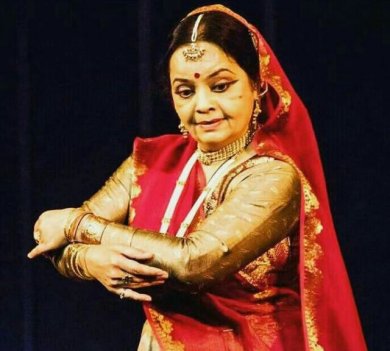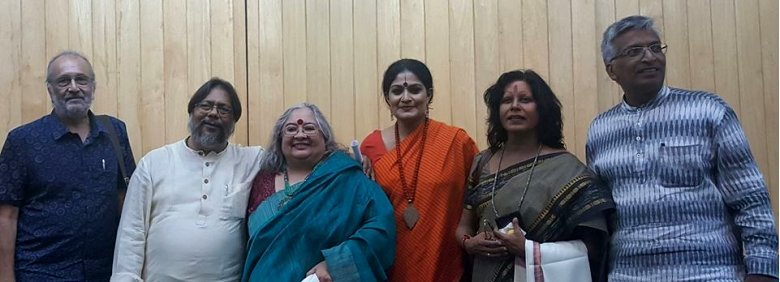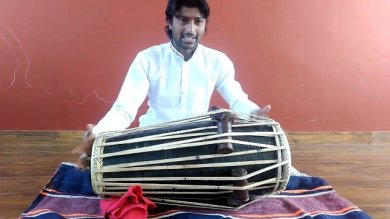
|   |

|   |
 e-mail: leelakaverivenkat@gmail.com Off the beaten track August 6, 2017 One offers heartfelt thanks to the rain Gods for their munificence to Delhi and its environs, notwithstanding the water logging on the streets posing bottlenecks with commuting problems - compelling most programmes to start later than scheduled. This is a small obstacle when viewed against the havoc of floods as in the north east and Gujarat, or the totally dry parched earth with drought in the southern cities causing endless water scarcity.  Prerana Shrimali Monsoons would seem to have stirred a new love for dialogues and discussions on art matters, gripping the performance calendar this month with all art institutions busy organising interactions on various themes. The IIC auditorium as the venue for a series of lectures on different subjects attracted a modest, motley and moving gathering of people of different age groups as listeners. Prerana Shrimali, an established Kathak dancer spoke on her perceptions of the dance form she represented. As a Rajasthani living in Jaipur, she was pushed as a child into learning Kathak. Studiously performing her ta thai thai tat footwork as a part of the process of growing up, she had no knowledge that what she was doing was Kathak. Like the average Jaipuria, being treated to different north Indian musical genres like Dhrupad, and other sashtriya art forms and even folk forms of Rajasthan, she grew up with no questions raised on why she did what she did. A wee bit older, when she began to train under Guru Kundanlal Gangani, the Japur gharana Kathak specialist, she began to be aware of gharanas in Kathak and wondered about the why, what and reason for these different streams, later realising that each school has its own aesthetics - emerging out of a unified approach to several aspects of the art form. Her initial consciousness of beauty was while watching her Guruji's thata. The simple, not particularly beautiful male form, ceased to exist as she became acutely conscious of the perfection of 'motion in stillness and stillness in motion' in his thata. While the present day Kathak dancer often dismisses thata as a tuning up process in a performance with the performer absorbing the musical refrain (lehra), allowing it to seep into mind and body, preparing the dancer for the rigours of the rest of the intra- forms to follow, realisation has made her aware that thata is the most difficult part of the dance - for to create a sense of stillness and silence even while inner rhythms in the dancer are working with minimal visual outward expression, is not easy. "My guruji's famous words were, "make the body light - even while doing the most heavy footwork." He would perform thata moving on a muslin dupatta spread on the floor - without causing the slightest crease on the cloth. That is how light footed he was even amidst sure-footed rhythm." The dancer spoke of often watching the Raigarh gharana Guru Kartik Ram dance to an avartan (one rhythmic cycle of the tala) of 64 counts in teental - which today is danced to 16 counts! Four times slower in those days, to dance in vilambit laya with people seated on all the sides watching as one performed in the centre, was a feat requiring an inner measurement of time which was phenomenal. Listening to exchanges on tala as she did between giants like Mohanrao Kalyanpurkar and Prof. Saxena was a luxury which students of Kathak today do not have. Guruji insisted that the nagma (musical refrain) should be such as to clearly bring out the nature of the tala. With no items taught, the Kathak dancer is given a large vocabulary of fleeting nritta bandishes and out of these he needs to cull out to create a rhythmic design which is his own. The Kathak dancer never says that he dances to a tala. He says that he dances a tala. The dancer during the recital builds up a form of the tala like a raga in music. This is a language of abstraction and formlessness, and no two persons present the same performance. The idea is to have several differing manifestations and not uniformity of that language. She quoted Antonio Porkiya, the Argentinean poet's words, "End comes through uniformity." And not having a prescribed format for the performance is the best way of keeping the open ended dance ever fresh. It is like writing poetry which has no grammar. In Kathak, one needs to create poetry each time. In a way one can create abhinaya out of abstraction and rhythm. Pendulum Dialogue - Body/Mind Connect  On July 28, at the Gulmohar hall of the Habitat, under the Pendulum Dialogues series of Legends of India, a modest gathering turned up for an exchange on the 'Body/Mind connect in the classical arts' with speakers representing different disciplines: Shakti Maira - artist/sculptor, Alka Raghuvanshi - writer/journalist/artist and curator of several art events, and dancers of Bharatanatyam and Kathak, Geeta Chandran and Shovana Narayan respectively. Moderating the session was Suresh Goel, ex-Director General of the ICCR. The discussion, after the moderator's brief introduction began with Geeta Chandran maintaining that in dance, body and mind are part of one construct. Right from a bhoomi pranam, without the involvement of mind, the gesture of mere obeisance would be empty. While the main vehicle for movement in dance may be the body, what gives it direction to move and provides the balance is the mind. And a teacher in class addresses the mind of the student while guiding body movement. Just body without mind has no place in dance. Shakti Maira, the sculptor dealing with material which has no mind, spoke of the inner human being in the artist and the pre-eminent spirit involved in art making. He spoke of motivation and intention of the artist. There were other aspects like the reactive element and also the responsive aspects of the art maker. With the analytical mind another factor is the response to the space one works in. The sensitised mind of the artist engaged in and enriched by the very process of making art, experiences a mix of mental, spiritual, sensory, emotional responses. That what one refers to as the mind has many aspects to it, was what the speaker had brought out. When a singer whose mind and heart are absorbed in building up the raga brick by brick, pauses and relishes with a "Aha'' what he himself has just created, it shows that the mind can create and respond to what it has created at the same time. Shovana Narayan in her impassioned way started with a line of poetry Jab mein tha, to Hari nahi, Jab Hari that ho mein nahi (When I was there, there was no Hari and when Hari was there, there was no I or me). In dance the mind/body have to be tuned to a higher level of consciousness which is reached when one is able to listen to the inner music in which space, the ego and persona of the dancer cease to exist. Referring to abhinaya and its improvisations, she spoke of a genius of the Kathak Guru who all night could revolve his expressional art round one word lal (red colour). Myriad interpretations with accent shift on words- as in a sentence like Kanha chhedomat, jaiyo na (Kanha, do not tease me, go) to Kanha chhedo matjaiyo (Kanha, tease me, do not go away). Alka Raghuvanshi spoke of the perceptions of an artist which are often different from those of the audience or viewer and bridging this gap and communicating the art is the problem faced in every art form. As a modern painter, she is faced with this dilemma very often for this art is highly individualistic. If she sees the colour of Spring as red, how does she convey that to the viewer who normally thinks of Vasant as green. For the dancer on the other hand, whose art demands strong physicality, with advancing years and correspondingly dwindling physical energy, her body has to rise to the ideational challenges posed by a more mature mind, with greater understanding of the art form. But then the artist has to develop a minimalism in expression where while standing still for example, one can suggest motion. The art, by having to shed virtuosity, can develop a leanness which at the same time says a lot. Thrown open to the house by the moderator, what followed was an animated discussion. Finding space for young talent At the ICCR auditorium of Azad Bhawan, Saurang Parampara Music Society of Moradabad gharana spearheaded by the sarangi and sitar twins Morad Ali and Fateh Ali, in association with Kathak dancer Mahua Shankar, mounted an unusual event featuring deserving, young talent struggling to find the opportunities and spaces they deserve. The discussion session preceding the evening programme had the organisers Fateh Ali and Murad Ali and Mahua Shankar along with tablist Akram Khan and two representatives from the art writing world, viz journalist Ravindra Misra and this critic. The observations mainly pertained to the closed roads young artists faced in being able to find some space to highlight their talents. Dogged by financial constraints, amidst hours having to be spent on reyaz to master an art form, the inability in finding sponsors or organisers for providing them a chance in any event, proved so daunting that the youngsters wondered if the art forms could flourish in such a hostile climate - wherein those who had ''arrived'' showed little desire to encourage less known talents. Seeing the frustration in youth pursuing art forms with the ordeals faced in getting to be known, along with not being able to provide for themselves and their families, these caring young artistes got together to do their bit by organising events providing a floor to the young and less known who have the quality. Indeed after listening to vocalists Shiraz and Feraz Ahmed Khan singing khayal in raga Megh, and the two sarangi brothers Amir Khan and Ghulam Mohammad Khan who played a sonorous Behag, one felt that rising talents of this nature certainly had a future and needed exposure.  Manoj Solanke The cream of the evening was the young pakhawaj player Manoj Solanke, a disciple of Santosh Das Anuragi, trained under the great Pagal Das, the simple guru showing his integrity by saying that while he taught some excellent students among whom was his son too, by far the best of them was Manoj, whose skill with a percussion instrument like pakhawaj, particularly in the tisra and khanda rhythms he rained on the audience, will long be remembered. Mahua Shankar's find after being treated to his playing in Rishikesh, he was also the triumph and high point of the festival. Like Geeta Chandran hosting a young dancers' festival every year at the IIC, it is heartening that other artists like Murad, Fateh and Mahua (all young themselves) are taking up the cause of the young.  Writing on the dance scene for the last forty years, Leela Venkataraman's incisive comments on performances of all dance forms, participation in dance discussions both in India and abroad, and as a regular contributor to Hindu Friday Review, journals like Sruti and Nartanam, makes her voice respected for its balanced critiquing. She is the author of several books like Indian Classical dance: Tradition in Transition, Classical Dance in India and Indian Classical dance: The Renaissance and Beyond. Post your comments Please provide your name and email id when you use the Anonymous profile in the blog to post a comment. All appropriate comments posted with name & email id in the blog will also be featured in the site. |